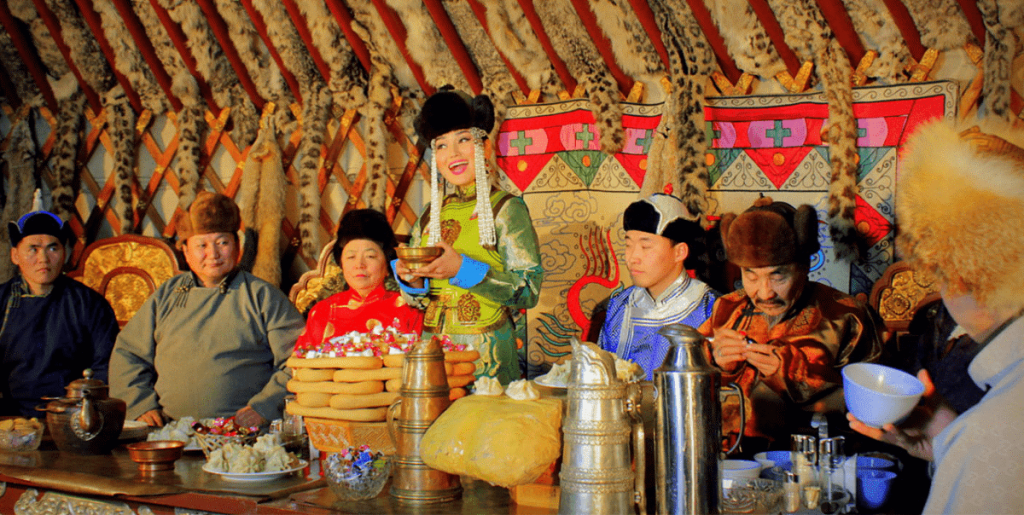Kharkhorin City Museum

Kharkhorin museum is small, but highly impressive – probably the country’s best museum outside Ulaanbaatar. Everything is beautifully designed and well displayed.
The exhibits include dozens of artifacts dating from the 13th and 14th centuries that were recovered from the immediate area, plus others that were found from archaeological sites in other parts of the provinces, including prehistoric stone tools. You’ll see pottery, bronzes, coins, religious statues, and stone inscriptions. There’s also a half-excavated kiln sunk into the museum floor.
Perhaps most interesting is the scale model of the ancient Karakorum, which aims to represent the city as it may have looked in the 1250s, and is based on descriptions written by the missionary William of Rubruck. Don’t miss the doco detailing the excavation of the 6th-century tomb of Shoroon Bumbagar, which is located 220km from Kharkhorin.
Erdenezuu Monastery

In the 1580s, by the order of Dalai Lama first temple of Erdenezuu monastery was built on the ruin of the Mongolian ancient capital the Karakorum. By the 1792s, there were 62 temples, over 500 buildings nearby. The monastery was registered in “Heritage of Mongolia” by UNESCO. Today:
Dalai Lama temple exposes 13 “nagtan” images of Mahakala, six images of 12 Dalai Lama’s emanations, and copper image of Under Gegeen Zanabazar, the first leader of Mongolian Buddhism.
Tsamba temple devoted to the deity Tsamba has three rooms. Four Lamas used to occupy each room to recite certain sutras.
West Zuu Temple was built by wish of Abtai Sain Khan, his son Ereehei Mergen’s queen Suntaihu and Holoch Darhan noyon’s mother. Three Buddhas in the center of the temple are Kasyapa, Shakyamuni, Maitreya.
Middle Zuu Temple was built by Abtai Sain Khan on the 15th of mid-month of the summer of fiery male dog year in old Takhai place.
East Zuu Temple was built at the request of Tusheet Khan Gombodorj and his queen Khandjamts. There are three statues and Janraiseg, Buddha Shakyamuni, Je Zonkhapa.
Orkhon River Waterfall

The waterfall falls from 24 m lava cliffs when the Ulaan River confluences the Orkhon River. Therefore, the waterfall is called differently such as Ulaantsutgalan or Orkhon Waterfall, or Orkhonii Khurkheree. The Ulaantsutgalan waterfall is one of the picturesque sights in the historically significant Orkhon River Valley, which requires bumpy driving through the lava-covered scenic valley full of nomads and their animals.
The waterfall locates 495 km from Ulaanbaatar, 135 km from Kharkhorin, and 30 km from the nearest town Bat-Ulziit of Uvurkhangai province.
Khuisiin Naiman Nuur Lakes

The Khuisiin Naiman Nuur or Eight Lakes were formed by volcanic eruptions centuries ago and are a part of the 11500 hectares Khuisiin Naiman Nuur Nature Reserve. These scenic lakes are accessible on horseback or hiking from the northern side. The Eight Lakes are called Shireet, Mukhar, Khaliut, Bugat, Khaya, Duruu, Khuis, and Onon located 500 m to 3 km to each other.
The area is extremely beautiful surrounded by coniferous tree-covered mountains and the forest clearings have multitudes of wildflowers, is a famous horse-riding destination in central Mongolia.
Tuvkhun Monastery

Tovkhon is one of the oldest Buddhist Monasteries in Mongolia and a famous Pilgrimage center, which was built on the 2312 m rocky top of Shiveet Ulaan Mountain hidden deep in the Khangai Mountain. The monastery was first named Dubkhen meaning “creation temple” and later turned to Tovkhon.
The monastery is accessible both from the eastern slope and western slope of the mountain. A return hiking takes 2.5 hours through scenic trails of coniferous tree-covered mountains, plus some sightseeing time. A sturdy 4WD can drive the steep road up about 20 min or you could hire a horse. Though, hiking to the monastery is the best and the safest way.
Elsen Tasarkhai – Khugnu Tarna Natural Reserve

Elsen Tasarkhai is a part of the Mongol Els sand dunes, that continues 80 km long 5 km wide across Burd, Bulgan, and Gurvanbulag soum of Uvurkhangai province. It is located 280 km west of Ulaanbaatar and 80 km east of Karakorum – the ancient Mongolian capital. The area is surrounded by sand dunes, hills covered with rare bushes, and a small forest near a river. Together this presents a unique combination of Mongolian mountains, forests, and Gobi-type landscape in one location. Local people call these sand dunes Duut mankhan (Singing sand).

































